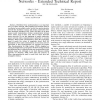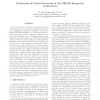380 search results - page 51 / 76 » Operation-valency and the cost of coordination |
INFOCOM
2006
IEEE
14 years 2 months ago
2006
IEEE
— Directional antennas are a promising option for use in ad-hoc networks for a variety of reasons, such as increased spatial reuse, reduced interference and enabling more effici...
INFOCOM
2006
IEEE
14 years 2 months ago
2006
IEEE
— Distributed time synchronization is an important part of a sensor network where sensing and actuation must be coordinated across multiple nodes. Several time synchronization pr...
IPPS
2006
IEEE
14 years 2 months ago
2006
IEEE
Due to the better utilization of computational and communication resources and the improved coordination of application subsystems, designers of large distributed embedded systems...
PADS
2006
ACM
14 years 2 months ago
2006
ACM
Simulation is a low cost alternative to experimentation on real-world physical systems. Grid technology enables coordinated use of and secure access to distributed computing resou...
HICSS
2005
IEEE
14 years 2 months ago
2005
IEEE
The electronic markets hypothesis (EMH) in the information systems (IS) literature suggests that information technology (IT) will reduce coordination costs across firms, leading t...


